Born May 31, 1973 in Bradenton, Florida, Tyrone Williams was in and out of trouble throughout his life, and his Packer career was maddening at times. Drafted from two-time national champion Nebraska in the third round of the 1996 despite a pending court case concerning Williams firing a gun at a car, Tyrone filled the third cornerback role for the championship Packers as a rookie. A year later, he replaced injured Craig Newsome as the team’s left cornerback for a second Super Bowl run. Williams then moved to the right side in 1998 and started there for five seasons.
Blessed with 4.38 speed in the forty, the 5’11” 195-pound Williams had great talent as a cover corner, but was inconsistent in his coverage and even more so in his tackling. At times, he was very physical and threw his body around recklessly, but at others, he would miss easy tackles to allow big plays. Add in a tendency to report to training camp in questionable shape and periodic off-field distractions, and his career is remembered as being undisciplined and disappointing. His season high of five interceptions came in 1998, and he scored twice on interception returns, once each in 2000 and 2001. Released in 2003, he spent a year with Atlanta and one with Dallas before leaving the game. There have been more tangles with the law since then, but, ironically, Williams has since formed TruPros, an organization to counsel NFL players in life issues.
(Adapted from Green Bay Gold.)






Custom cards in a variety of styles.

















































































